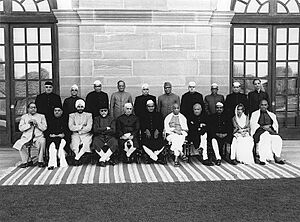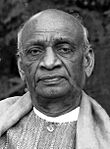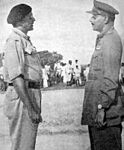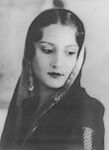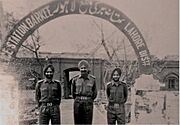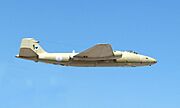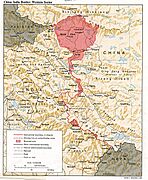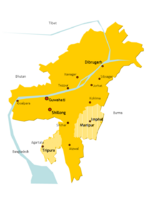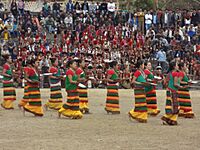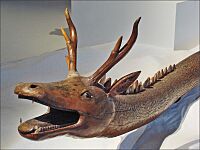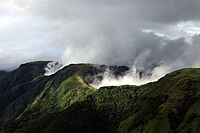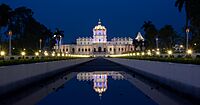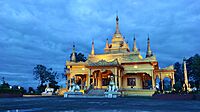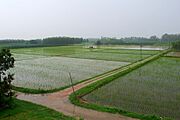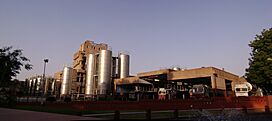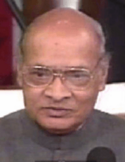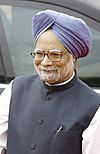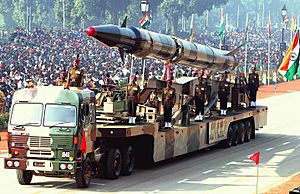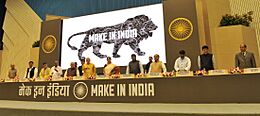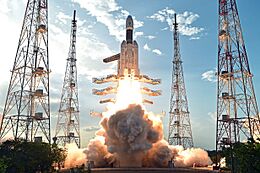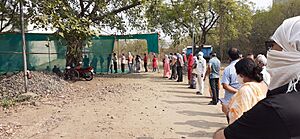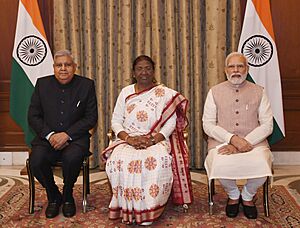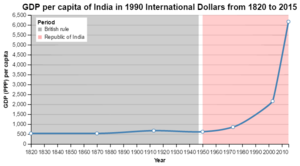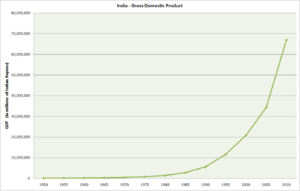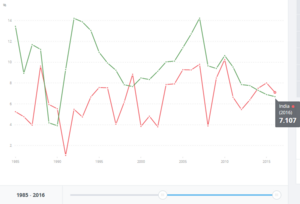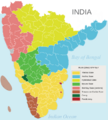History of India (1947–present) facts for kids

The history of independent India began when the country became a free and self-governing nation on 15 August 1947. Before this, India was ruled directly by the British since 1858. When British rule ended in 1947, the country was divided into two separate nations based on religion: India, with a majority of Hindus, and Pakistan, with a majority of Muslims. This division, called the Partition of India, caused more than 10 million people to move between India and Pakistan, and about one million people died.
Jawaharlal Nehru, a leader of the Indian National Congress, became India's first Prime Minister. However, Mahatma Gandhi, who was most famous for leading the independence struggle, did not take any government job. In 1950, India adopted its Constitution, making it a democratic republic with a parliamentary government. India has remained a democracy ever since, which is special among newly independent countries.
India has had disagreements over land with China, leading to wars in 1962 and 1967. It also has disputes with Pakistan, resulting in wars in 1947, 1965, 1971, and 1999. During the Cold War, India stayed neutral and was a leader in the Non-Aligned Movement. However, it formed a loose alliance with the Soviet Union from 1971, while Pakistan was allied with the United States and China.
India is a nuclear-weapon state. It conducted its first nuclear test in 1974 and five more tests in 1998. From the 1950s to the 1980s, India followed socialist-inspired policies. The economy had many rules, protected local businesses, and was largely owned by the government. This led to slow economic growth. Since 1991, India has made its economy more open and free. Today, India is the third largest and one of the fastest-growing economies in the world.
From a struggling start, India has become a fast-growing major economy. It is sometimes seen as a great power and a potential superpower because of its large and growing economy, strong military, and huge population.
Contents
India's Early Years (1947–1950)
Independent India's first few years were full of big changes. There was a huge exchange of people with Pakistan, a war with Pakistan in 1947, and the joining of over 500 princely states to form one united nation. Leaders like Vallabhbhai Patel, Jawaharlal Nehru, and Mahatma Gandhi made sure that India's new constitution would be secular, meaning it would treat all religions equally.
The Partition of India
The division of India was decided by the Indian Independence Act 1947. This act ended British rule in South Asia and created two independent countries: India and Pakistan. The new borders divided two large British provinces, Bengal and Punjab. Areas with a Muslim majority went to Pakistan, and areas with a non-Muslim majority went to India. Other things like the army, navy, air force, railways, and money were also divided. India and Pakistan officially became independent at midnight on 14 and 15 August 1947.
The partition caused many deaths and a massive movement of people between the two new countries. People who survived the journey often felt safer among those who shared their religion. It is believed that between 14 million and 18 million people moved, and about one million people died during this time. The violence of the partition created a lasting feeling of distrust between India and Pakistan.
About 3.5 million Hindus and Sikhs living in areas that became Pakistan moved to India, fearing for their safety. Violence killed an estimated one million Hindus, Muslims, and Sikhs. This greatly affected the border regions of Punjab and Bengal, and cities like Calcutta, Delhi, and Lahore. The violence stopped by early September thanks to the efforts of Indian and Pakistani leaders, especially Mohandas Gandhi. Gandhi went on a fast to encourage peace, even though it put his life at risk. Both governments set up large camps for refugees, and the Indian Army helped provide aid.
I find no parallel in history for a body of converts and their descendants claiming to be a nation apart from the parent stock.
On 30 January 1948, Nathuram Godse assassinated Mohandas Gandhi. Godse blamed Gandhi for the partition and believed he was too kind to Muslims. More than a million people filled the streets of Delhi to follow Gandhi's funeral procession and say their last goodbyes.
In 1949, nearly one million Hindu refugees came to India from East Pakistan (now Bangladesh) due to violence and threats. This angered Hindus and Indian nationalists, and the refugees strained India's resources. Prime Minister Nehru and Sardar Patel invited Pakistan's Prime Minister Liaquat Ali Khan for talks in Delhi. They signed a pact promising to protect minorities and set up commissions for them. Patel supported this pact for peace, helping to get support from across India. Khan and Nehru also signed a trade agreement and promised to solve problems peacefully. Many Hindus returned to East Pakistan, but the improved relations did not last long, mainly because of the Kashmir dispute.
|
||||||
Joining of Princely States
In 1946, Jawaharlal Nehru said that no princely state could stand against the army of independent India. By 1947, he declared that independent India would not accept the idea of kings ruling by "divine right." He also said that any princely state refusing to join the Constituent Assembly would be seen as an enemy.
British India had 17 provinces and 565 princely states. The provinces were given to India or Pakistan. However, the rulers of the princely states could choose to remain independent or join either India or Pakistan. This meant India's leaders faced a country that could be broken into many small, independent kingdoms.
Under the leadership of Sardar Vallabhbhai Patel, the new Indian government used talks and, sometimes, military action to make sure the central government and the new Constitution were supreme. Sardar Patel and V. P. Menon convinced most rulers of states next to India to join India. Many rights and special payments (called privy purses) were promised to these rulers to encourage them to join. Some rulers were even made governors of the new merged states. Many small states were combined to form larger, easier-to-manage states like Saurashtra and PEPSU. Some states like Tripura and Manipur joined later in 1949.
Three states were harder to bring into India:
- Junagadh: This state had a Hindu majority but a Muslim ruler. In December 1947, a vote showed 99% wanted to join India, canceling the ruler's decision to join Pakistan.
- Hyderabad: This state had a Hindu majority but a Muslim ruler (Nizam). After talks failed, Patel ordered the Indian army to take control in September 1948. This operation was called Operation Polo. Hyderabad became a state of India the next year.
- Jammu and Kashmir: This state had a Muslim majority but a Hindu king. It quickly became a source of conflict, leading to the First Indo-Pakistani War from 1947 to 1949. A UN-backed ceasefire left India in control of two-thirds of the area. The Indian Constitution came into force in Kashmir in 1950 with special rules for the state.
India's Constitution
The Constituent Assembly adopted the Constitution of India on 26 November 1949. It officially came into effect on 26 January 1950. This new constitution replaced the old British law as the country's main governing document. India then became the Republic of India.
The Constitution declared India a sovereign, socialist, secular, and democratic republic. It promised its citizens justice, equality, and liberty, and aimed to promote fraternity (brotherhood). Important features of the Constitution included:
- Voting rights for all adults.
- A parliamentary system of government at both the national and state levels.
- An independent court system.
The Constitution also required the government to set aside a certain percentage of places in education, jobs, and political bodies for "socially and educationally backward citizens." The Constitution has been changed more than 100 times since it was first made. India celebrates its Constitution on 26 January as Republic Day.
First War with Pakistan (1947–1948)
The Indo-Pakistani War of 1947–1948 was fought between India and Pakistan over the princely state of Kashmir and Jammu. It was the first of four wars between the two new nations. Pakistan started the war by sending tribal fighters into Kashmir a few weeks after independence, hoping to take control of the region. A ceasefire, arranged by the United Nations, began on 5 January 1949.
India lost 1,104 soldiers and had 3,154 wounded. Pakistan lost about 6,000 soldiers and had 14,000 wounded. Most people agree that India won the war because it successfully defended most of the disputed territory.
Governing India (1950s-1960s)
India held its first national elections under the new Constitution in 1952. More than 60% of people voted. The Indian National Congress won by a huge margin, and Jawaharlal Nehru began his second term as prime minister. President Prasad was also re-elected.
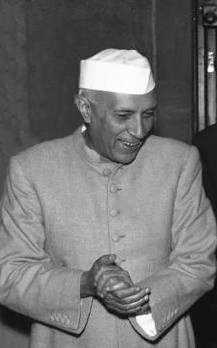
Nehru's Time as Prime Minister (1952–1964)
Nehru is often seen as the founder of modern India. He had a clear vision for the country, focusing on national unity, democracy, industrial growth, and scientific development. He also believed India should not take sides in the Cold War. These ideas helped many parts of society, like public workers and industries. However, some groups, like the poor and Hindu nationalists, felt left out.
After Vallabhbhai Patel died in 1950, Nehru became the most important national leader. This allowed him to put his plans for India into action without much opposition.
Nehru's economic policies focused on making goods within India instead of importing them. He supported a mixed economy, where the government controlled important industries alongside private businesses. He believed that building basic and heavy industries like steel, iron, coal, and power was essential for India's development. The government invested heavily in these public sector industries, supporting them with money and protective policies.
Nehru led the Congress party to win more elections in 1957 and 1962. During his time, the Indian Parliament passed laws that gave more legal rights to women in Hindu society. They also made laws against discrimination based on caste and against untouchability. Nehru strongly encouraged primary education for all children. Thousands of schools, colleges, and advanced learning centers, like the Indian Institutes of Technology, were started across the country.
Nehru favored a socialist model for India's economy. After independence, a formal planning system was adopted. The Planning Commission was set up in 1950, with Nehru as its head. This commission created Five-Year Plans for economic development, similar to the Soviet model. These plans included no taxes for farmers, minimum wages for workers, and the government taking control of heavy industries like steel, aviation, and mining. Village common lands were used for public works, leading to the building of major dams, irrigation canals, roads, and power stations.
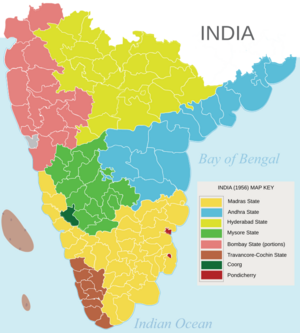
Reorganizing States
In 1952, Potti Sreeramulu died after a long hunger strike, demanding a separate state for Telugu-speaking people. This event led to a major reorganization of India's states. Nehru appointed the States Re-organisation Commission, and based on its advice, the States Reorganisation Act was passed in 1956. Old states were dissolved, and new states were created based on shared languages and ethnic groups.
For example, the separation of Kerala and the Telugu-speaking parts of Madras State led to the creation of a state just for Tamil-speaking people, called Tamil Nadu. On 1 May 1960, the states of Maharashtra and Gujarat were formed from the old bilingual Bombay State. On 1 November 1966, the larger Punjab state was divided into a smaller, Punjabi-speaking Punjab and a Haryanvi-speaking Haryana.
Growth of Many Political Parties
Before independence, the main parties in India were the Congress and the Muslim League. There were also other smaller parties with limited reach. After the partition, the Muslim League lost its importance, and the Congress party dominated Indian politics in the 1950s. However, this began to change in the 1960s and 1970s. Many new parties were formed, including those started by former Congress leaders like the Swatantra Party, various socialist parties, and the Bharatiya Jan Sangh, which was linked to the Hindu nationalist RSS.
Swatantra Party
On 4 June 1959, after a meeting of the Indian National Congress, C. Rajagopalachari, along with others, announced the creation of the new Swatantra Party. This party was conservative and was supported by former rulers of princely states. Later, other important figures like N. G. Ranga and K. M. Munshi joined.
Rajagopalachari believed that India needed a strong right-wing party to oppose the Congress, which had moved towards socialist ideas. He said that the opposition should work openly through elections. He outlined the party's goals, which included equality and opposing government control over private businesses. Rajagopalachari strongly criticized the government's complex system of permissions and licenses needed to start a business, calling it the "licence-permit Raj." His strong personality became a key feature of the party.
Rajagopalachari tried to build a front against the Congress, even working with his former opponent C. N. Annadurai of the Dravida Munnetra Kazhagam (DMK). The Swatantra Party won six seats in the Madras state assembly elections and 18 parliamentary seats in the 1962 Lok Sabha elections.
Foreign Policy and Wars
Nehru's foreign policy was the basis for the Non-Aligned Movement, which India helped start. Nehru kept good relations with both the United States and the Soviet Union. He also encouraged China to join the global community. In 1956, when Egypt took control of the Suez Canal, India supported Egypt. India opposed the division of Palestine and the 1956 invasion of Sinai. However, it did not oppose China's control over Tibet or the Soviet Union's actions in Hungary.
Although Nehru said India would not develop nuclear weapons, Canada and France helped India build nuclear power stations for electricity. In 1960, India also made an agreement with Pakistan about sharing the waters of seven rivers. Nehru visited Pakistan in 1953, but political problems in Pakistan prevented any progress on the Kashmir dispute.
India has fought four wars or military conflicts with its neighbor, Pakistan. Two of these happened during this period. In the Indo-Pakistani War of 1947, fought over Kashmir, Pakistan took one-third of Kashmir, and India took three-fifths. In the Indo-Pakistani War of 1965, India attacked Pakistan after Pakistani troops tried to enter Indian-controlled Kashmir.
In 1961, after many requests for a peaceful transfer, India invaded and took control of the Portuguese colony of Goa on India's west coast.
In 1962, China and India fought a short war, the Sino-Indian War, over their border in the Himalayas. India suffered a complete defeat, which led to India focusing more on building up its military and improving relations with the United States. China withdrew from some disputed territory it had crossed during the war. India still claims the smaller Aksai Chin territory that China controls on the western part of the border.
-
Indian Army officers captured a Police Station in Lahore, Pakistan, during the Indo-Pakistani War of 1965.
-
The Indian Air Force used Canberra bombers against Portuguese forces during Operation Vijay to take Goa.
-
Disputed areas in the western part of the Sino-Indian border, including Aksai Chin, shown on a 1988 CIA map.
India After Nehru (1960s)
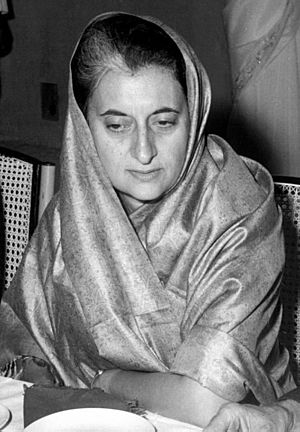
Jawaharlal Nehru died on 27 May 1964. Lal Bahadur Shastri became the next prime minister. In 1965, India and Pakistan fought another war over Kashmir, but it ended without a clear winner or change in the border. The Tashkent Agreement was signed with the help of the Soviet government, but Shastri died the night after the signing.
After Shastri's death, Indira Gandhi, Nehru's daughter, became the third prime minister. She had been the Minister for Information and Broadcasting. She won against Morarji Desai. The Congress Party won fewer seats in the 1967 elections because people were unhappy about rising prices, unemployment, and food shortages. Indira Gandhi's start was difficult after she agreed to lower the value of the rupee, which caused problems for Indian businesses and consumers.
In 1967, India and China had another conflict in the Sino-Indian War of 1967. Chinese soldiers fired on Indian soldiers who were building a fence on the border in Nathu La. Indian forces successfully pushed back the Chinese, leading to China's withdrawal from Sikkim.
Morarji Desai joined Gandhi's government as deputy prime minister. He and other senior Congress politicians tried to limit Gandhi's power. But Gandhi, advised by P. N. Haksar, regained popularity by moving towards socialist policies. She successfully ended the special payments (Privy Purse) for former Indian royalty. She also took on the party leadership by nationalizing India's banks. Although Desai and businesses opposed this, it was popular with the public. When Congress politicians tried to remove Gandhi by suspending her party membership, many members of parliament left to join her new party, Congress (R). The Indian National Congress split in 1969. Gandhi continued to govern with a small majority.
India in the 1970s
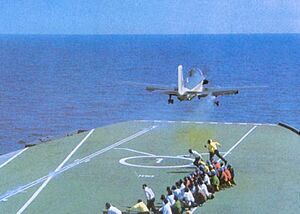
In 1971, Indira Gandhi and her Congress (R) party won a huge majority in the elections. Banks were nationalized, and many other socialist economic policies were put in place. India intervened in the Bangladesh War of Independence, a civil war in Pakistan's Bengali region. This happened after millions of refugees fled the Pakistani army's actions. The conflict led to the independence of East Pakistan, which became Bangladesh. This made Prime Minister Indira Gandhi extremely popular. Relations with the United States became strained, and India signed a 20-year friendship treaty with the Soviet Union, moving away from its non-aligned policy for the first time. In 1974, India tested its first nuclear weapon in the desert of Rajasthan.
Sikkim Joins India
In 1973, there were riots against the king in the Kingdom of Sikkim. In 1975, the Prime Minister of Sikkim asked the Indian Parliament for Sikkim to become a state of India. In April of that year, the Indian Army took over the capital city of Gangtok and disarmed the king's guards. A vote was then held, where 97.5 percent of voters supported ending the monarchy and joining India.
India reportedly had many troops in Sikkim during the vote. On 16 May 1975, Sikkim became the 22nd state of the Indian Union, and the monarchy was ended. To make this happen, the Indian Parliament changed the Indian Constitution. First, the 35th Amendment made Sikkim an "associate state." A month later, the 36th Amendment made Sikkim a full state.
New States in the Northeast
In Northeast India, the state of Assam was divided into several smaller states starting in 1970. In 1963, the Naga Hills district became the 16th state of India, named Nagaland. In 1970, the districts of Khasi Hills, Jaintia Hills, and Garo Hills were formed into an autonomous state within Assam, which became a separate state called Meghalaya in 1972. Also in 1972, Arunachal Pradesh and Mizoram were separated from Assam as union territories. Both became full states in 1986.
-
Pakhangba, a dragon symbol important in Manipur. Manipur became a state on 21 January 1972.
-
Meghalaya is a mountainous state known for heavy rain. Meghalaya became a state on 21 January 1972.
-
Ujjayanta Palace, now the Tripura State Museum. Tripura became a state on 21 January 1972.
-
Golden Pagoda, Namsai, Arunachal Pradesh, a notable Buddhist temple. Arunachal Pradesh became a state on 20 February 1987.
-
A school in Mizoram, a state with high literacy. Mizoram became a state on 20 February 1987.
Green Revolution and Operation Flood
India's population reached over 500 million in the early 1970s. The country's long-standing food problems were solved by the Green Revolution. This was a period of greatly improved farming. The government supported modern farming tools, new types of seeds, and more financial help for farmers. This increased the yield of food crops like wheat, rice, and corn, as well as commercial crops like cotton and tea. Farming productivity grew across the Indo-Gangetic Plain and Punjab.
Under Operation Flood, the government encouraged milk production, which increased greatly. This also improved livestock farming across India. These efforts helped India become self-sufficient in feeding its own people, ending two decades of needing to import food.

Bangladesh Liberation War
The Indo-Pakistani War of 1971 was the third war between India and Pakistan. It was fought in December 1971 over the issue of Bangladesh. India decisively defeated Pakistan, leading to the creation of Bangladesh.
The crisis began when the Pakistani army, mostly from Punjab, refused to give power to the newly elected but mainly Bengali Awami League, led by Shaikh Mujibur Rehman. The Proclamation of Bangladeshi Independence in March 1971 by Rehman led to widespread violence by the Pakistani army against certain groups. It is estimated that between 300,000 and 3,000,000 civilians were killed in Bangladesh starting in March 1971.
The official war began with Pakistan's air force launching strikes on Indian air stations. These strikes caused minor damage and led to India declaring war on Pakistan. India joined the war to support the Bengali nationalist forces fighting for East Pakistan's independence. India's entry expanded the conflict to both the eastern and western fronts. Thirteen days into the war, India had complete control in the East and strong control in the West. This led to the Pakistani forces in the East signing a surrender document on 16 December 1971 in Dhaka. This officially ended the conflict and marked the formation of East Pakistan as the new nation of Bangladesh. About 93,000 Pakistani soldiers were taken prisoner by the Indian Army.
The Indian Emergency
Leading to the Emergency
In the early 1970s, India faced high inflation due to the 1973 oil crisis, which greatly increased the cost of oil imports. There were also costs from the Bangladesh war and refugee resettlement, and food shortages caused by droughts. These economic and social problems, along with accusations of corruption against Indira Gandhi's government, led to growing political unrest across India in 1973–74. This included a major railway strike and student protests.
Raj Narain, who lost to Indira Gandhi in the 1971 elections, accused her of using unfair practices. Four years later, on 12 June 1975, the Allahabad High Court found Indira Gandhi guilty of misusing government resources for her election campaign. Opposition parties held nationwide strikes and protests, demanding her immediate resignation. Various political parties united under Jaya Prakash Narayan to oppose what he called Gandhi's dictatorship. Narayan even called for the army to remove Gandhi.
Emergency Declared
On 25 June 1975, Gandhi advised President Fakhruddin Ali Ahmed to declare a state of emergency under the constitution. This gave the central government vast powers to maintain law and order. Gandhi said her main reasons were a breakdown of law and order and a threat to national security. She suspended many civil liberties and postponed elections. Non-Congress governments in Indian states were removed, and nearly 1,000 opposition leaders and activists were imprisoned. Strikes and public protests were banned.
Life During the Emergency
India's economy improved because strikes and political disorder ended. India announced a 20-point program that boosted farming and industrial production, increasing national growth and jobs. However, many government officials and Congress politicians were accused of corruption and acting like dictators. Police were accused of arresting innocent people. Indira's son, Sanjay Gandhi, was blamed for serious abuses, including the demolition of slums in Delhi, which caused deaths and injuries.
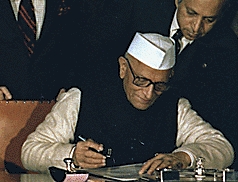
Janata Party Takes Over
Indira Gandhi's Congress Party called for general elections in 1977. They suffered a huge defeat to the Janata Party, which was a group of opposition parties. Morarji Desai became India's first non-Congress Prime Minister. Desai's government set up investigations into abuses during the Emergency. Indira and Sanjay Gandhi were arrested after a report from the Shah Commission.
In 1979, the Janata Party coalition fell apart, and Charan Singh formed a temporary government. The Janata Party became very unpopular due to internal conflicts and a perceived lack of leadership in solving India's economic and social problems.
India in the 1980s
Indira Gandhi and her Congress Party group, "Congress(I)", returned to power with a large majority in January 1980.
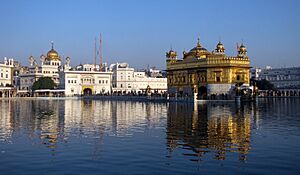
However, a growing uprising in Punjab threatened India's security. In Assam, there was violence between local villagers and refugees. When Indian forces, in an operation called Operation Blue Star, raided the hideout of militants in the Golden Temple (the holiest shrine for Sikhs) in Amritsar, civilians were accidentally killed, and the temple was damaged. This angered the Sikh community across India. The government used strong police actions to stop militant operations, but this led to many claims of civil liberties being abused. Northeast India was also affected by conflicts between the ULFA and government forces.
On 31 October 1984, the Prime Minister's own Sikh bodyguards assassinated her. This led to the 1984 anti-Sikh riots in Delhi and parts of Punjab, killing thousands of Sikhs. Some senior members of the Congress Party were accused of encouraging the violence. Government investigations have not yet fully identified and punished those responsible, but public opinion blamed Congress leaders for directing attacks on Sikhs in Delhi.

Rajiv Gandhi's Government
The Congress party chose Rajiv Gandhi, Indira's older son, as the next prime minister. Rajiv had only been elected to Parliament in 1982. At 40, he was the youngest national political leader and prime minister ever. But his youth and lack of experience were seen as good things by people who were tired of old politicians and wanted new policies to solve the country's problems. Parliament was dissolved, and Rajiv led the Congress party to its biggest majority ever, winning over 415 out of 545 seats. This was partly due to public sympathy after his mother's assassination.
Rajiv Gandhi started many reforms. The Licence Raj (strict government rules for businesses) was relaxed. Government limits on foreign money, travel, foreign investment, and imports were greatly reduced. This allowed private businesses to operate more freely, and more foreign investment came into India. As prime minister, Rajiv improved relations with the United States, which led to more economic aid and scientific cooperation. Rajiv's support for science and technology led to a big expansion of the telecommunications industry and India's space program. It also helped create the software industry and information technology sector.
In December 1984, a deadly gas leak happened at the Union Carbide pesticides plant in Bhopal. Thousands died immediately, and many more died later or were left disabled. This is considered the worst industrial disaster in history.
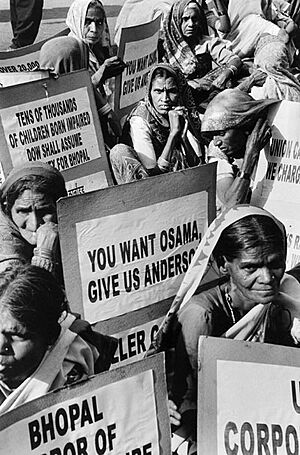
In 1987, India made an agreement with Sri Lanka and sent troops to help with peacekeeping in Sri Lanka's ethnic conflict, led by the LTTE. Rajiv sent Indian troops to enforce the agreement and disarm the Tamil rebels. However, the Indian Peace Keeping Force (IPKF) got caught in violence and ended up fighting the Tamil rebels themselves. They also became targets for Sri Lankan nationalists. V. P. Singh withdrew the IPKF in 1990, but thousands of Indian soldiers had died.
Rajiv's move away from socialist policies was not popular with everyone, especially those who did not benefit from the changes. Unemployment was a serious problem, and India's growing population created more needs for limited resources.
Rajiv Gandhi's image as an honest politician was damaged when the Bofors scandal broke out. This revealed that senior government officials had taken bribes for defense contracts.
Janata Dal Government
The general elections in 1989 resulted in Rajiv's Congress winning the most seats, but not a majority.
Power instead went to his former finance and defense minister, VP Singh of Janata Dal. Singh had been moved to the Defense ministry after he uncovered some scandals that made the Congress leadership uncomfortable. Singh then exposed the Bofors scandal and was removed from his party and office. Becoming a popular leader for reform, Singh led the Janata Dal coalition to form a government. He was supported by the BJP and leftist parties from outside. As Prime Minister, Singh visited the Golden Temple to help heal past wounds. He also put into action the Mandal Commission report, which increased job and education quotas for lower-caste Hindus. His government fell after the BJP withdrew its support in November 1990. Chandra Shekhar then formed a new government with support from Rajiv's Congress, but this also collapsed in a few months.
India in the 1990s
The Chief Minister of Jammu and Kashmir, Farooq Abdullah, formed an alliance with the ruling Congress party for the 1987 elections. However, the elections were reportedly rigged in his favor. This led to the rise of an armed extremist movement in Jammu and Kashmir. India has always blamed Pakistan for providing these groups with support, weapons, and training.
Militants in Kashmir reportedly killed local Kashmiri Pandits, forcing many of them to leave Kashmir in the 1990s. This resulted in the ethnic cleansing of Kashmiri Hindus.
On 21 May 1991, while former prime minister Rajiv Gandhi was campaigning in Tamil Nadu, he was assassinated. In the elections, Congress (Indira) won 244 parliamentary seats and formed a coalition. They returned to power under the leadership of P.V. Narasimha Rao. This Congress-led government served a full five-year term. It began a gradual process of opening up the Indian economy to global trade and investment. India's domestic politics also changed, as traditional groups based on caste and ethnicity gave way to many small, regional political parties.
However, India was hit by communal violence between Hindus and Muslims, which killed over 10,000 people. This followed the demolition of the Babri Mosque by Hindu extremists in December 1992. In the final months of the Rao government in 1996, several major political corruption scandals occurred. These contributed to the Congress Party's worst election performance at that time, as the Hindu nationalist Bharatiya Janata Party (BJP) became the largest single party.
Economic Reforms
Under the policies started by Prime Minister P. V. Narasimha Rao and his Finance Minister Dr. Manmohan Singh, India's economy grew quickly. These economic reforms were a response to a major financial crisis in 1991. The Rao government began selling off large, inefficient government companies. They also reduced taxes and interest rates, and ended many government monopolies, allowing foreign investment in many areas.
Since then, the general direction of economic opening has remained the same. Cities like Bangalore, Hyderabad, and Pune have become important economic centers, attracting foreign investment. Strategies like creating Special Economic Zones (areas with tax benefits and good infrastructure) have helped industries grow.
A new generation of educated professionals in science and technology began to drive the Indian economy. The information technology industry grew across India with more computers. New technologies made almost every industry more efficient. Foreign investment and outsourcing jobs to India further boosted India's economic growth. A large middle class has emerged, increasing demand for various goods. Unemployment is falling, and poverty has dropped to about 22%. Gross Domestic Product (GDP) growth increased to over 7%. While challenges remain, India is experiencing a period of economic growth that has made it a leading global economy and increased its influence in the world.
Era of Coalitions
The Bharatiya Janata Party (BJP) became the largest party in the Lok Sabha after the May 1996 national elections, but it did not have enough seats to form a majority government. Under Prime Minister Atal Bihari Vajpayee, the BJP coalition lasted only 13 days. To avoid another election, a 14-party group led by the Janata Dal, known as the United Front, formed a government. This government, led by former Chief Minister of Karnataka H. D. Deve Gowda, lasted less than a year. The Congress Party withdrew its support in March 1997. Inder Kumar Gujral then became the Prime Minister of a 16-party United Front coalition.
In November 1997, the Congress Party again withdrew support for the United Front. New elections in February 1998 resulted in the BJP winning the most seats (182), but still not a majority. On 20 March 1998, a BJP-led coalition government was formed with Vajpayee as prime minister again. On 11 and 13 May 1998, this government conducted five underground nuclear weapons tests, known as Pokhran-II. This led Pakistan to conduct its own tests that same year. India's nuclear tests caused the United States and Japan to impose economic sanctions on India and led to widespread international criticism.
In early 1999, Prime Minister Vajpayee made a historic bus trip to Pakistan and met with Pakistan's prime minister Nawaz Sharif. They signed the bilateral Lahore peace declaration.
In April 1999, the BJP-led coalition government fell apart, leading to new elections in September. In May and June 1999, India discovered a large-scale infiltration by terrorists, which led to the Kargil War in Kashmir. This derailed a promising peace process that had begun just three months earlier. Indian forces fought back the Pakistan-backed infiltrators and recaptured important border posts in high-altitude warfare.
After the successful end of the Kargil conflict, the National Democratic Alliance (NDA), a new coalition led by the BJP, won a majority and formed a government with Vajpayee as prime minister in October 1999. The end of the millennium was devastating for India, as a cyclone hit Orissa, killing at least 10,000 people.

India in the 2000s
Under the BJP
In May 2000, India's population went over 1 billion. US President Bill Clinton made an important visit to India to improve relations between the two countries. In January 2001, massive earthquakes hit Gujarat state, killing at least 30,000 people.
Prime Minister Vajpayee met with Pakistan's President Pervez Musharraf in mid-2001, the first summit between Pakistan and India in over two years. However, the meeting failed without any major progress due to differences over the Kashmir region.
Three new states—Chhattisgarh, Jharkhand, and Uttarakhand—were formed in November 2000.
The National Democratic Alliance government's reputation was affected by political scandals and reports of intelligence failures that led to the Kargil conflict going unnoticed. After the September 11 attacks, the United States lifted sanctions it had placed on India and Pakistan in 1998. This was seen as a reward for their support in the War on Terror. Tensions between India and Pakistan rose again due to heavy Indian firing on Pakistani military posts and the deadly Indian Parliament attack and the 2001–02 India–Pakistan standoff.
In 2002, 59 Hindu pilgrims returning from Ayodhya were killed in a train fire in Godhra, Gujarat. This sparked the 2002 Gujarat riots, leading to the deaths of 790 Muslims and 254 Hindus.
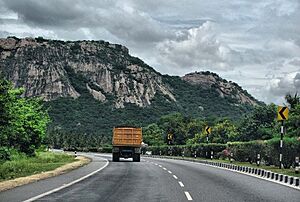
Throughout 2003, India's fast economic progress, political stability, and new peace efforts with Pakistan increased the government's popularity. India and Pakistan agreed to restart direct air travel. A groundbreaking meeting was held between the Indian government and moderate Kashmir separatists. The Golden Quadrilateral project aimed to connect India's corners with a network of modern highways.
Congress Returns to Power
In January 2004, Prime Minister Vajpayee called for early general elections. An alliance led by the Congress Party, called the United Progressive Alliance (UPA), won a surprise victory in the elections held in May 2004. Manmohan Singh became the Prime Minister after Congress President Sonia Gandhi declined the position. Manmohan Singh became the first Sikh and non-Hindu to hold India's most powerful office. Singh continued economic reforms, though support from Indian Socialists and Communists delayed further privatization for some time.
By the end of 2004, India began to withdraw some of its troops from Kashmir. By mid-2005, the Srinagar–Muzaffarabad Bus service was started, the first in 60 years between Indian-administered and Pakistani-administered Kashmir. However, in May 2006, suspected Islamic extremist militants killed 35 Hindus in Kashmir.
The 2004 Indian Ocean earthquake and tsunami devastated Indian coastlines and islands, killing an estimated 18,000 people and displacing around 650,000. Other natural disasters, like the Mumbai floods (killing over 1,000) and the 2005 Kashmir earthquake (killing 79,000), hit the subcontinent the next year. In February 2006, the United Progressive Alliance government launched India's largest rural jobs program, aiming to lift about 60 million families out of poverty.
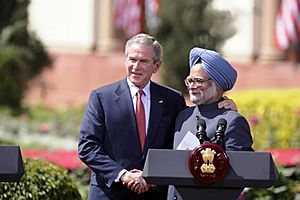
The United States and India signed a major nuclear cooperation agreement during a visit by US President George W. Bush in March 2006. Under this deal, the United States would give India access to civilian nuclear technology, while India agreed to more checks on its nuclear program. Later, the United States approved a law allowing India to buy their nuclear reactors and fuel for the first time in 30 years. In July 2008, the United Progressive Alliance government survived a vote of confidence after left-wing parties withdrew their support over the nuclear deal. Within three months, after approval by the U.S. Congress, George W. Bush signed the nuclear deal with India into law.
In 2007, India got its first female President, Pratibha Patil. In February, the infamous Samjhauta Express bombings killed Pakistani civilians in Panipat, Haryana. As of 2011, no one had been charged for the crime.
In October 2008, India successfully launched its first mission to the Moon, an uncrewed lunar probe called Chandrayaan-1. The previous year, India had launched its first commercial space rocket, carrying an Italian satellite.
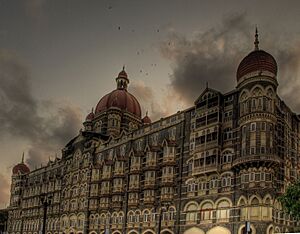
In November 2008, the 2008 Mumbai attacks took place. India blamed militants from Pakistan for the attacks and announced a "pause" in the ongoing peace process.
In the Indian general election in 2009, the United Progressive Alliance won a strong victory, with Congress alone winning 206 seats. However, the Congress-led government faced many accusations of corruption. Inflation rose to a record high, and increasing food prices caused widespread public anger.
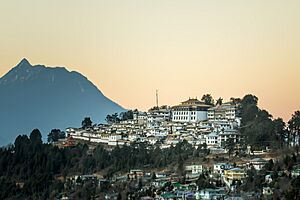
On 8 November 2009, despite strong protests from China, which claims all of Arunachal Pradesh, the 14th Dalai Lama visited Tawang Monastery in Arunachal Pradesh. This was a monumental event for the people of the region, and the monastery's abbot welcomed him with great celebration.
21st-century India faces the Naxalite–Maoist rebels, which Prime Minister Manmohan Singh called India's "greatest internal security challenge." There are also other terrorist threats, such as Islamist terrorist campaigns in Jammu & Kashmir and terrorism in India's Northeast. Terrorism has increased in India, with bomb blasts in major cities like Mumbai, New Delhi, Jaipur, and Hyderabad. In the new millennium, India improved relations with many countries and unions, including the United States, the European Union, Israel, and China. The economy of India has grown very quickly. India was now seen as a potential superpower.
India in the 2010s
Congress Rule Continues
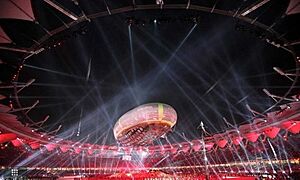
Concerns and controversies over the 2010 Commonwealth Games shook the country in 2010. This raised questions about the government's honesty, followed by the 2G spectrum case and Adarsh Housing Society scam. In mid-2011, Anna Hazare, a well-known social activist, went on a 12-day hunger strike in Delhi. He was protesting government proposals to fight corruption, which he felt were not strong enough.
Despite these issues, India showed great promise with a higher growth rate in its economy. In January 2011, India took a temporary seat on the United Nations Security Council for 2011–12. In 2004, India had applied for a permanent seat on the UN Security Council, along with Brazil, Germany, and Japan. In March, India became the world's largest importer of arms, surpassing China.
The Telangana movement reached its peak in 2011–12, leading to the formation of India's 29th state, Telangana, in June 2014.
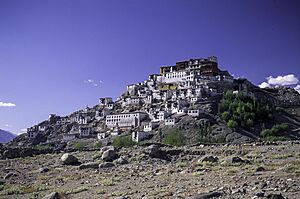
In August 2010, sudden heavy rains and resulting flooding in the Ladakh region of North India killed about 255 people and affected 9,000. In June 2013, a multi-day cloudburst in Uttarakhand and other north Indian states caused devastating floods and landslides. More than 5,700 people were presumed dead. In September 2014, floods in Jammu and Kashmir, due to heavy monsoon rains, killed around 277 people and caused extensive property damage. Another 280 people died in neighboring Pakistani regions.
In August–September 2013, clashes between Hindus and Muslims in Muzaffarnagar, Uttar Pradesh, resulted in at least 62 deaths, 93 injured, and over 50,000 displaced.
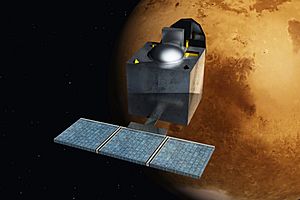
In November 2013, India launched its first mission to Mars, the Mars Orbiter Mission, also known as Mangalyaan. It was successful, and on 24 September 2014, ISRO became the fourth space agency to reach Mars, after the Soviet Union, NASA, and the European Space Agency. ISRO also became the first space agency and India the first country to reach Mars on its first attempt.
2014 – BJP Government Returns
The Hindutva movement, which supports Hindu nationalism, started in the 1920s and has been a strong political force in India. The main party of the religious right since the 1950s was the Bharatiya Jana Sangh. The Jana Sangh joined the Janata party in 1977. When that party broke apart, former members of Jana Sangh formed the Bharatiya Janata Party (BJP) in 1980. The BJP grew its support in the following decades and is now the most powerful political party in India.
In September 2013, the Chief Minister of Gujarat, Narendra Modi, was named the BJP's candidate for prime minister for the 2014 Lok Sabha election. Modi played a major role in the BJP's election campaign. The 16th national general election, held in early 2014, saw a huge victory for the BJP-led NDA. The alliance gained a clear majority and formed a government under Prime Minister Modi. The Modi government's strong win helped the BJP win several state elections. The Modi government started several initiatives and campaigns to increase manufacturing and infrastructure, notably — Make in India, Digital India, and the Swachh Bharat Mission.
The largest tax reform in India's history, the Goods and Services Tax (GST), was introduced in 2017.
India carried out the 2019 Balakot airstrike when its airplanes flew across the de facto border in Kashmir and dropped bombs in Balakot, Pakistan. After a dogfight between Indian and Pakistani fighter pilots, Abhinandan Varthaman, an Indian wing commander, was captured by Pakistan. Under pressure from world leaders, Pakistan was compelled to release the Indian pilot.
By ending Article 370 of the Indian Constitution, the state of Jammu and Kashmir was divided into two separate union territories: Jammu and Kashmir and Ladakh. The BJP government introduced the Citizenship Amendment Act in 2019, which led to widespread protests.
-
10th President of Israel Reuven Rivlin and Chief of General Staff of the Israel Defense Forces Gadi Eizenkot with PM Modi, the first Indian Prime Minister to visit Israel.
India in the 2020s
In February 2020, riots broke out in Delhi. The Citizenship Amendment Act protests were described as a cause. Tensions increased on the India-China border after clashes between Indian and Chinese troops began on 5 May 2020. The Rama Janmabhoomi temple construction officially started after a ground-breaking ceremony by Prime Minister Modi on 5 August 2020. Farm reform laws, which later became very controversial, were passed in September 2020 with very little debate.
After a year-long protests by farmers, Prime Minister Modi repealed the laws in November 2021. This was done quickly in Parliament without debate.
COVID-19 Pandemic
The COVID-19 pandemic in India began on 30 January 2020, with the first case reported in Thrissur. Two months later, in March 2020, Prime Minister Modi imposed a complete lockdown across the country with only four hours' notice. This was to stop the spread of COVID-19. Millions lost their jobs, and many lost their lives. The Indian economy also shrank significantly.
In September 2020, India's health minister stated that the country planned to approve and begin distributing a vaccine by early 2021. Vaccination against COVID-19 started in India on 16 January 2021. By early April 2021, a second wave of infections hit the country with severe consequences. This second wave put a major strain on the healthcare system, including a shortage of medical oxygen. The number of new cases began to drop by late May, and vaccination gained momentum again. India administered 1 billion doses of COVID-19 vaccine on 21 October 2021. Although the official number of COVID-related deaths in India is less than half a million, the total number of excess deaths from all causes has been estimated at between 3 and 5 million.
Post-COVID India
On 25 July 2022, Droupadi Murmu was sworn in as India's new president. She became India's first tribal president, which was a historic event, even though the president's role is largely ceremonial. India celebrated 75 years of its independence from the British Empire on 15 August 2022. In April 2023, India surpassed China to become the most populous country on Earth, with over 1.425 billion people. India was chosen to host the 2023 G20 New Delhi summit from 9 to 10 September 2023.
Chandrayaan-3, a lunar lander developed by ISRO, landed on the moon on 23 August 2023. This made India the 4th country to land on the moon, after the Soviet Union, China, and the United States. ISRO also became the first space agency and India the first country to reach the Moon's south pole.
General elections were held in India from 19 April to 1 June 2024 to elect members of the 18th Lok Sabha. The BJP won 240 seats, fewer than its 303 seats in 2019, and lost its single majority in the Lok Sabha. Modi confirmed the support of 293 NDA Members of Parliament to President Draupadi Murmu. This marked Modi's third term as prime minister and his first time leading a coalition government, with the Telugu Desam Party and Janata Dal (United) as key allies.
Economy of India
The economic history of India since 1947 can be divided into two main periods:
- 1947-1991: This period saw a lot of government involvement in the economy and slow economic growth.
- 1991–Present: This period saw fewer government rules, fast economic growth, and a reduction in poverty.
Before Economic Opening (1947–1991)
After independence, India's economic policy was shaped by its experience under colonial rule, which was seen as unfair. Indian leaders were influenced by British social democracy and the planned economy of the Soviet Union. India's domestic policy focused on protecting its own industries, making goods at home instead of importing them, and having a large government-run sector. There were many business rules and central planning. Trade and foreign investment policies were quite strict. The Five-Year Plans of India were similar to the central planning used in the Soviet Union. Industries like steel, mining, and telecommunications were taken over by the government in the mid-1950s. India's economy during this time is often called "Dirigism," meaning it was heavily directed by the state.
Jawaharlal Nehru, India's first prime minister, along with statistician Prasanta Chandra Mahalanobis, created and oversaw economic policy in the early years. They hoped their strategy, which involved quickly developing heavy industry with both public and private sectors, would lead to good results. This strategy relied on direct and indirect government involvement, rather than a strict Soviet-style command system.
Since 1965, the use of high-yielding seeds, more fertilisers, and better irrigation facilities all contributed to the Green Revolution in India. This greatly improved farming by increasing crop production and strengthening links between farming and industry. However, some have criticized it as not being sustainable, leading to more capitalist farming, ignoring needed reforms, and increasing income differences.
In 1984, Rajiv Gandhi promised to open up the economy. He made V. P. Singh the finance minister, who tried to reduce tax evasion. Tax revenues increased because of this crackdown, even though taxes were lowered. This process lost momentum later in Mr. Gandhi's term due to scandals in his government.
After Economic Opening (Since 1991)
The fall of the Soviet Union, which was India's main trading partner, and the Gulf War, which caused oil prices to rise sharply, led to a major financial crisis for India. India faced the possibility of not being able to pay its loans. India asked for a $1.8 billion loan from the International Monetary Fund (IMF), which in return demanded fewer government rules.
In response, the Narasimha Rao government, including Finance Minister Manmohan Singh, started economic reforms in 1991. These reforms ended the Licence Raj, reduced tariffs and interest rates, and ended many government monopolies. They also allowed foreign direct investment in many sectors. Since then, the main goal of opening up the economy has remained the same. By the early 21st century, India had moved towards a free-market economy, with much less government control and more financial freedom. This has led to longer life expectancy, higher literacy rates, and better food security, though people in cities have benefited more than those in rural areas.
In the second decade of this century, the economy of India rose from the ninth-largest to the fifth-largest economy in the world by nominal GDP, surpassing the UK, France, Italy, and Brazil. The economy had started to slow down in the second term of Manmohan Singh's time as prime minister. However, it began to recover in 2013–14, with the GDP growth rate increasing to 6.4% from 5.5% the previous year. This acceleration continued through 2014–15 and 2015–16, with growth rates of 7.5% and 8.0% respectively in the early years of Narendra Modi's first term. However, the growth rate later slowed down to 7.1% and 6.6% in 2016–17 and 2017–18, partly due to the effects of the 2016 Indian banknote demonetisation and the Goods and Services Tax (India).
COVID-19 and Aftermath (2020–Present)
During the COVID-19 pandemic, many rating agencies lowered India's GDP predictions for the financial year 2021 to negative numbers. This signaled a recession in India, the most severe since 1979. The Indian economy shrank by 6.6%, which was less than the estimated 7.3% decline. In 2022, the ratings agency Fitch Ratings upgraded India's outlook to stable, similar to S&P Global Ratings and Moody's Investors Service's outlooks. In the first three months of the financial year 2022–2023, the Indian economy grew by 13.5%.
Images for kids
See also
- Economic history of India
- Economy of India
- Military history of India
- Outline of ancient India
- Politics of India
- The Emergency (India)
- India (disambiguation)
- Licence Raj


